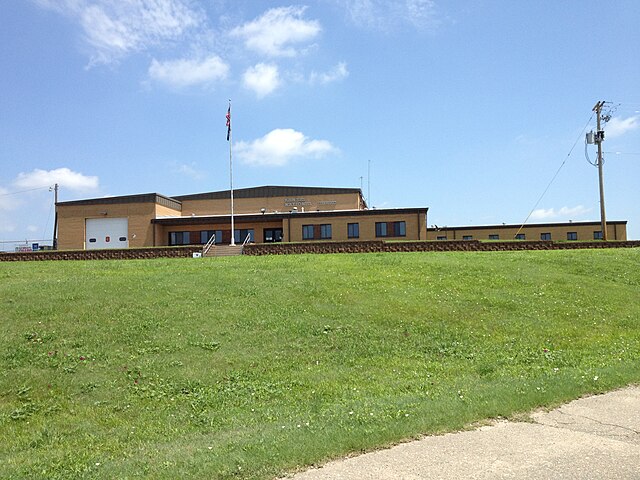National Guard Armory
From Wikipedia, the free encyclopedia
A National Guard Armory, National Guard Armory Building, or National Guard Readiness Center[note 1] is any one of numerous buildings of the U.S. National Guard where a unit trains, meets, and parades. A readiness center supports the training, administration, and logistics of National Guard units by providing assembly space, classrooms, weapons and protective personal equipment storage, and training space.[2]: 4 Readiness centers can also be utilized as communal assembly areas, utilized by local organizations and governments.[2]: 45

History
After World War II, the Section 5 Committee of the Office of the Chief of Staff, War Department, chaired by MG Milton Reckord, approved a policy of constructing National Guard armories using 75% federal and 25% state funding.[3] In 1968, the Army National Guard had 2,786 armories;[4] in 2000 the Army National Guard had 3,166 armories in 2,679 communities.[5] In 2009, the Kansas Adjutant General's Department announced it would be closing 18 of its then-56 National Guard armories "due to state budget cuts."[6]
A report to Congress in 2014 noted that some National Guard armories are in poor or failing condition, with "the average nationwide [Readiness Center] condition [being] fair, but bordering on poor…".[2]: 10 The report noted that the $377 million annual expenditure for constructing and improving readiness centers would produce "major long-term risks," and recommended more than quadrupling annual funding to "get to green" on key performance indicators by completely transforming and modernizing the portfolio of readiness centers.[2]: 13–14
Crime
In the 20th century, a number of national guard armories were the target of burglaries and weapons theft.[7]
Bonnie and Clyde acquired many of the weapons used for their crime sprees, such Browning Automatic Rifles, through theft from National Guard Armories.[8]
Some of the burglaries were linked to radicalism, as in the case of Katherine Ann Power, who stole weapons from multiple armories in the 1970s.[9] A particularly notable case in 1974 involved the theft of a huge arms cache from the Compton National Guard Armory in California, in which nearly 100 M-16 rifles and several rocket launchers were stolen.[10] Several suspects were eventually arrested in 1975. The magnitude of this crime was considered analogous to most dangerous kind of terrorist threats.[11]
In 1995, former soldier Shawn Nelson stole an M60A3 tank from a National Guard armory in San Diego and went on a rampage throughout the city until he was shot dead by police.[12]
Specific armories in the United States
- National Guard Armory (Batesville, Arkansas), listed on the NRHP in Arkansas
- National Guard Armory Building (Searcy, Arkansas), formerly listed on the NRHP in White County, Arkansas
- National Guard Armory (Mena, Arkansas), listed on the NRHP in Arkansas
- National Guard Armory-Pine Bluff, Pine Bluff, Arkansas, listed on the NRHP in Arkansas
- Fort Homer W. Hesterly Armory, Tampa, Florida, listed on the NRHP in Florida
- Old West Palm Beach National Guard Armory, West Palm Beach, Florida, listed on the NRHP in Florida
- Villisca National Guard Armory, Villisca, Iowa, listed on the NRHP in Iowa
- Minneapolis Armory, Minneapolis, Minnesota, listed on the NRHP in Minnesota
- Kearney National Guard Armory, Kearney, Nebraska, listed on the NRHP in Buffalo County, Nebraska
- Hoosick Falls Armory, Hoosick Falls, New York
- Schenectady Armory, Schenectady, New York
- National Guard Armory (Fort Mill, South Carolina), listed on the NRHP in South Carolina
- The Houston Light Guard Armory, Houston, TX (Now the Buffalo Soldiers National Museum), listed on the NRHP in Texas
- The D.C. Armory, a multi-use facility adjacent to RFK Stadium in Washington, D.C.
- National Guard Armory 127th Regiment Infantry Company G, Oconomowoc, Wisconsin, listed on the NRHP in Wisconsin
See also
Notes
References
External links
Wikiwand - on
Seamless Wikipedia browsing. On steroids.
